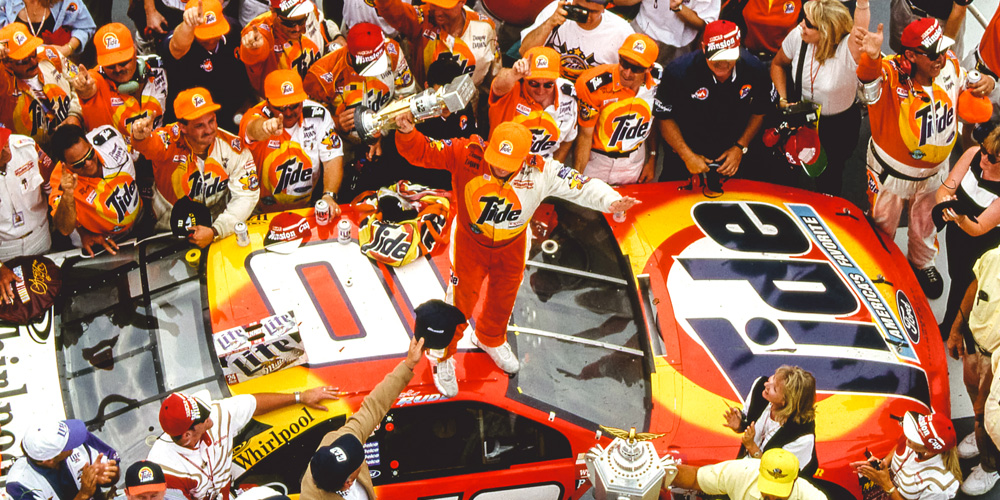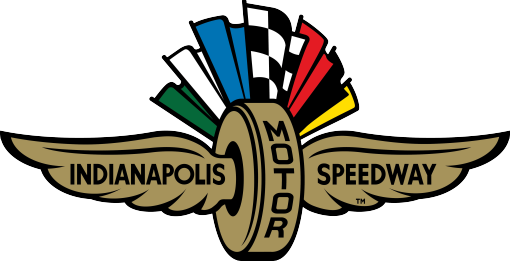Editor’s Note: This is the fourth of a five-part series looking back at the top 25 moments in the 24-year history of the Big Machine Vodka 400 at the Brickyard Powered by Florida Georgia Line. The moments will be unveiled five at a time, starting with No. 25 and finishing with No. 1. The 25th Running of the event is scheduled for Sept. 7-9 at IMS. Previous Moments | 15-11, 20-16 and 25-21.

No. 10: Rudd delivers closest win. The first three winners of the Big Machine Vodka 400 at the Brickyard Powered by Florida Georgia Line were giants in NASCAR history – Cup Series champions Jeff Gordon, Dale Earnhardt and Dale Jarrett.
But Ricky Rudd struck a chord for the “little guy” in 1997 by becoming the only driver to win in the first 16 editions of the Brickyard without also winning a Cup title during his career. Rudd also still is the only owner-driver to win the race in its 24-year history.
While Rudd never won a Cup championship, he was no slouch during his 32-year career at the pinnacle of NASCAR. He won 23 career races, and his victory in 1997 at the Indianapolis Motor Speedway was filled with as much courage and guile as any.
Rudd qualified seventh and drove to the lead for the first time on Lap 114, when he stopped for fuel. That was 46 laps from the end of the race, and the normal pit window for this event was approximately 10 laps less.
But as the laps wound down, Rudd stayed on track. He took the lead on Lap 147 when leader Jeff Burton was penalized for speeding during his final pit stop, but nearly everyone in the packed grandstands at IMS figured Rudd would need to stop for a splash of fuel to make it to the finish, spoiling his chance at victory.
Everyone but Rudd and his Rudd Performance Motorsports crew, that is.
The huge crowd held its collective breath over the last 14 laps to see if Rudd could hold off a charging Bobby Labonte while stretching his fuel run to the checkered flag, a mind-boggling 46 laps since his last stop. A three-lap caution period ensured Rudd made it to the finish ahead of Labonte by just .183 of a second – still the closest finish in the event’s 24-year history.
Rudd finally ran out of gas – on the cooldown lap as he prepared to enter Victory Lane for the biggest win of his career.
No. 9: Elliott becomes oldest winner. Maybe we should have seen this one coming.
Bill Elliott entered the 2002 Big Machine Vodka 400 at the Brickyard Powered by Florida Georgia Line on the heels of winning the previous event on the NASCAR Cup Series schedule, at Pocono. He also had finished in the top 10 in six of his first eight Brickyard starts.
It was his second consecutive year with a victory with Evernham Motorsports, which he joined in 2001 after its formation by legendary crew chief Ray Evernham. 1988 Cup Series champion Elliott had been winless since 1994 until he won in 2001 at Homestead-Miami.
But Elliott didn’t dominate the previous race, at Pocono, leading 35 of the 175 laps. He also was 46 and heading toward the twilight of his career, so some looked at the Pocono win as a nice triumph for a guy enjoying a late-career renaissance but no longer among NASCAR’s elite.
Yet Elliott looked every bit like the imperious “Awesome Bill from Dawsonville” of the 1980s a week later at the Brickyard.
Elliott lead 93 of 160 laps in his No. 9 Dodge. Elliott and Evernham paved the way to Victory Lane in a pre-Brickyard test session, during which they ignored qualifying speed and focused on performance over long fuel runs.
That strategy paid off. Elliott hunted down Rusty Wallace on a green-flag run late in the race, using four fresher tires to passing fellow Cup champion Wallace – who took just two tires on his previous stop – for the lead in Turn 3 on Lap 149.
Elliott pulled away and then held off Wallace and the rest of the field on the final restart, with four laps to go, for one of the sweetest victories of his Hall of Fame career. He was 46 years old while standing in Victory Lane and still is the oldest winner in Brickyard history.
No. 8: Gordon, Smoke take one final lap. The 2016 Big Machine Vodka 400 at the Brickyard Powered by Florida Georgia Line was a symbol of the changing of the guard for the race and the NASCAR Cup Series.
Brash young star Kyle Busch earned his first Brickyard victory in 2015 – also winning the Lilly Diabetes 250 NASCAR Xfinity Series race at IMS – and entered the 2016 race as a favorite to repeat.
Meanwhile, two of the biggest stars to ever race stock cars at IMS – Jeff Gordon and Tony Stewart – were making their final starts in the race. Both were multi-time winners of the event, Gordon a record five times and Stewart twice. Both were Hoosier fan favorites, Gordon living in nearby Pittsboro as a teenager and Stewart growing up in nearby Columbus. Both raced in USAC short-track competition throughout the Midwest before moving to NASCAR.
Gordon’s return to the Brickyard was unexpected. He retired after the 2015 season, returning to the seat for part of the 2016 season only as a substitute for injured teammate Dale Earnhardt Jr. Stewart had announced at the end of the 2015 season that 2016 would be his last year in a Cup car.
Neither driver got the desired result in their Brickyard sendoff. Stewart finished 11th and Gordon 13th, as Busch earned his second consecutive Brickyard victory, again in NASCAR’s overtime.
Late in the race, Stewart’s pit crew communicated to Gordon’s crew that “Smoke” wanted to turn a final lap side by side with Gordon after the checkered flag. So while Busch headed to Victory Lane, Stewart and Gordon took that slow, ceremonial final trip around the 2.5-mile oval side by side, window nets down and left hands in the air to acknowledge the crowd.
It was one of the most poignant moments in the history of the race, a fitting farewell to two Brickyard legends.
No. 7: Thousands flock to tire test. The arrival of stock cars for an International Race of Champions test in March 1992 at the Indianapolis Motor Speedway was met with equal parts curiosity and heresy by Wing and Wheel faithful.
Some fans were curious about how the heavier, fendered cars would run on the 9-degree banking of the turns at IMS, far flatter than the 30-plus degree banking at the Daytona and Talladega superspeedways.
Other fans wanted Speedway officials to preserve the facility for the Indy cars and Indianapolis 500 only. The “500” was the only race that had run at IMS since the Harvest Classic for open-wheel cars in fall 1916, and stock cars never had raced on the 2.5-mile oval.
The test by three IROC drivers proved the facility would need improvements to safely accommodate the heavier stock cars, so the idea of an IROC race during the Month of May leading up to the Indianapolis 500 was scrapped.
But there was enough of a spark during the IROC test for IMS and NASCAR officials to realize something special was igniting.
So nine top Cup Series teams were invited to a test June 22-23, 1992 at IMS. It was announced as a Goodyear tire test, but everyone involved – IMS and NASCAR officials, teams, drivers, media and fans – figured it could be a dry run to prepare for a Cup Series race at the Speedway.
Would the cars run well? Would the drivers react positively to IMS, which until then was the exclusive playground of the open-wheel world? Would any fans show up to the test?
The answer to all three of those questions was a resounding yes.
Tens of thousands of fans filled grandstands to watch the test, some chanting, “We want a race. We want a race.” Rusty Wallace was so excited to become the first Cup Series driver to turn a lap at IMS that he raced rival Dale Earnhardt off pit lane to get on track first. NASCAR and IMS officials were guarded in their comments but knew after this test that the wall between NASCAR and the Speedway was about to crumble.
Sure enough, IMS started a large improvement project after the test to enhance the track to accommodate stock cars. And IMS President Tony George and NASCAR President Bill France Jr. jointly announced April 14, 1993 that the inaugural Brickyard 400 would take place Aug. 6, 1994.
A star was born, with big help from a two-day test session in June 1992.

No. 6: Earnhardt reigns in classic. The 1995 Big Machine Vodka 400 at the Brickyard was worth the wait for Dale Earnhardt, in more ways than one.
Legendary seven-time Cup champion Earnhardt was at the peak of his incredible skills when NASCAR first raced at IMS in 1994, the odds-on favorite to win the inaugural. He started second and brushed the wall early while fighting pole sitter Rick Mast for the lead and never recovered, finishing fifth.
One year later, Earnhardt returned as the race favorite. But “The Intimidator” and the rest of the field had to wait out a rain delay of four hours to start the race as the remaining fury of Hurricane Erin rolled through Indiana.
Once the race started, one of the cleanest and fastest Brickyard races unfolded, with just one caution period. Reigning race winner Jeff Gordon won the pole, and 1988 Cup champion Bill Elliott led the most laps, with 47.
Earnhardt, who started 13th in the No. 3 Goodwrench Chevrolet, only led once. But he made it count. Earnhardt took the lead on Lap 137 and led the last 28 laps to edge fellow Cup champion and rival Rusty Wallace by .37 of a second as the checkered flew at 8:03 p.m. (ET), nine minutes after the official sunset in Indianapolis.
After seeing Wallace become the first Cup Series driver to turn a lap on the IMS oval during a test in 1992 and Gordon become the first driver to win a Cup Series race at IMS in 1994, Earnhardt was finally first at the Brickyard.
It was the most prestigious victory in Earnhardt’s Hall of Fame career to that point, topped only by his sole Daytona 500 win, in 1998.




